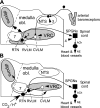Central CO2 chemoreception and integrated neural mechanisms of cardiovascular and respiratory control
- PMID: 20075262
- PMCID: PMC2853202
- DOI: 10.1152/japplphysiol.00712.2009
Central CO2 chemoreception and integrated neural mechanisms of cardiovascular and respiratory control
Abstract
In this review, we examine why blood pressure (BP) and sympathetic nerve activity (SNA) increase during a rise in central nervous system (CNS) P(CO(2)) (central chemoreceptor stimulation). CNS acidification modifies SNA by two classes of mechanisms. The first one depends on the activation of the central respiratory controller (CRG) and causes the much-emphasized respiratory modulation of the SNA. The CRG probably modulates SNA at several brain stem or spinal locations, but the most important site of interaction seems to be the caudal ventrolateral medulla (CVLM), where unidentified components of the CRG periodically gate the baroreflex. CNS P(CO(2)) also influences sympathetic tone in a CRG-independent manner, and we propose that this process operates differently according to the level of CNS P(CO(2)). In normocapnia and indeed even below the ventilatory recruitment threshold, CNS P(CO(2)) exerts a tonic concentration-dependent excitatory effect on SNA that is plausibly mediated by specialized brain stem chemoreceptors such as the retrotrapezoid nucleus. Abnormally high levels of P(CO(2)) cause an aversive interoceptive awareness in awake individuals and trigger arousal from sleep. These alerting responses presumably activate wake-promoting and/or stress-related pathways such as the orexinergic, noradrenergic, and serotonergic neurons. These neuronal groups, which may also be directly activated by brain acidification, have brainwide projections that contribute to the CO(2)-induced rise in breathing and SNA by facilitating neuronal activity at innumerable CNS locations. In the case of SNA, these sites include the nucleus of the solitary tract, the ventrolateral medulla, and the preganglionic neurons.
Figures

References
-
- Ainslie PN, Duffin J. Integration of cerebrovascular CO2 reactivity and chemoreflex control of breathing: mechanisms of regulation, measurement, and interpretation. Am J Physiol Regul Integr Comp Physiol 296: R1473–R1495, 2009 - PubMed
-
- Antunes VR, Brailoiu GC, Kwok EH, Scruggs P, Dun NJ. Orexins/hypocretins excite rat sympathetic preganglionic neurons in vivo and in vitro. Am J Physiol Regul Integr Comp Physiol 281: R1801–R1807, 2001 - PubMed
-
- Aston-Jones G, Chen S, Zhu Y, Oshinsky ML. A neural circuit for circadian regulation of arousal. Nat Neurosci 4: 732–738, 2001 - PubMed
Publication types
MeSH terms
Substances
Grants and funding
LinkOut - more resources
Full Text Sources
Research Materials

